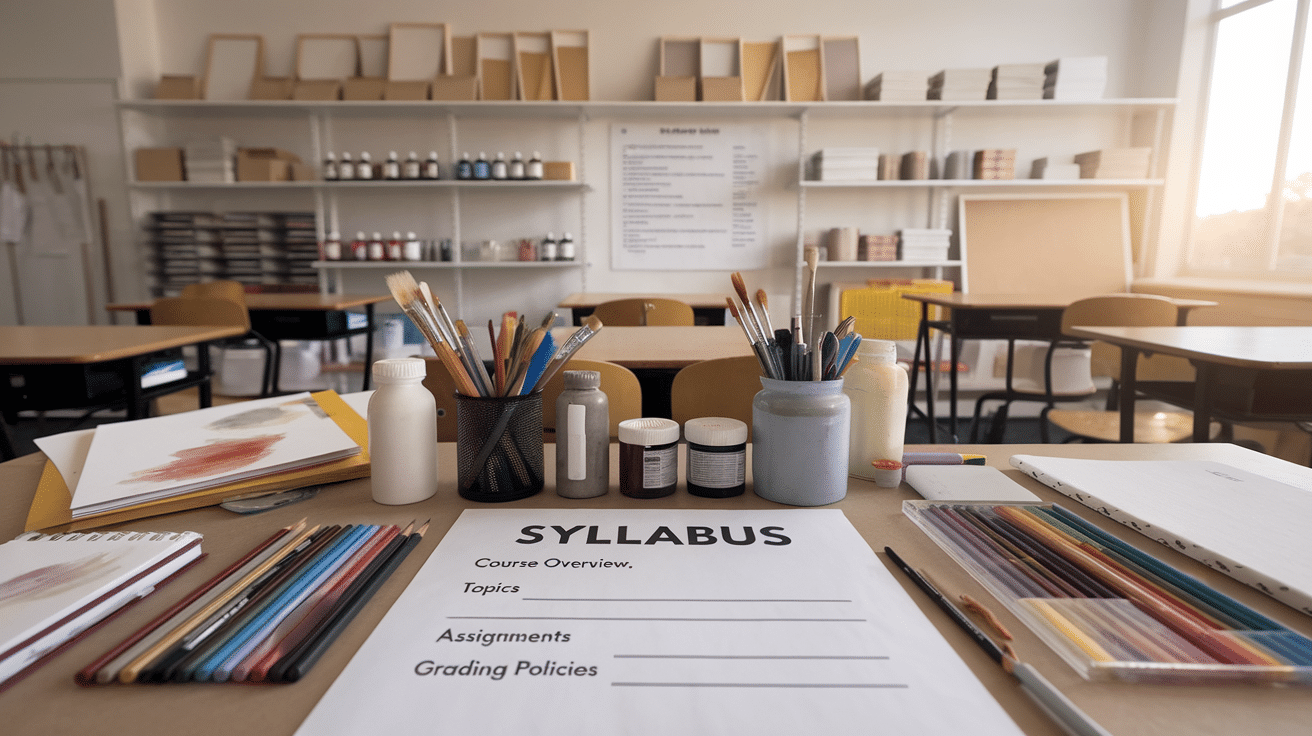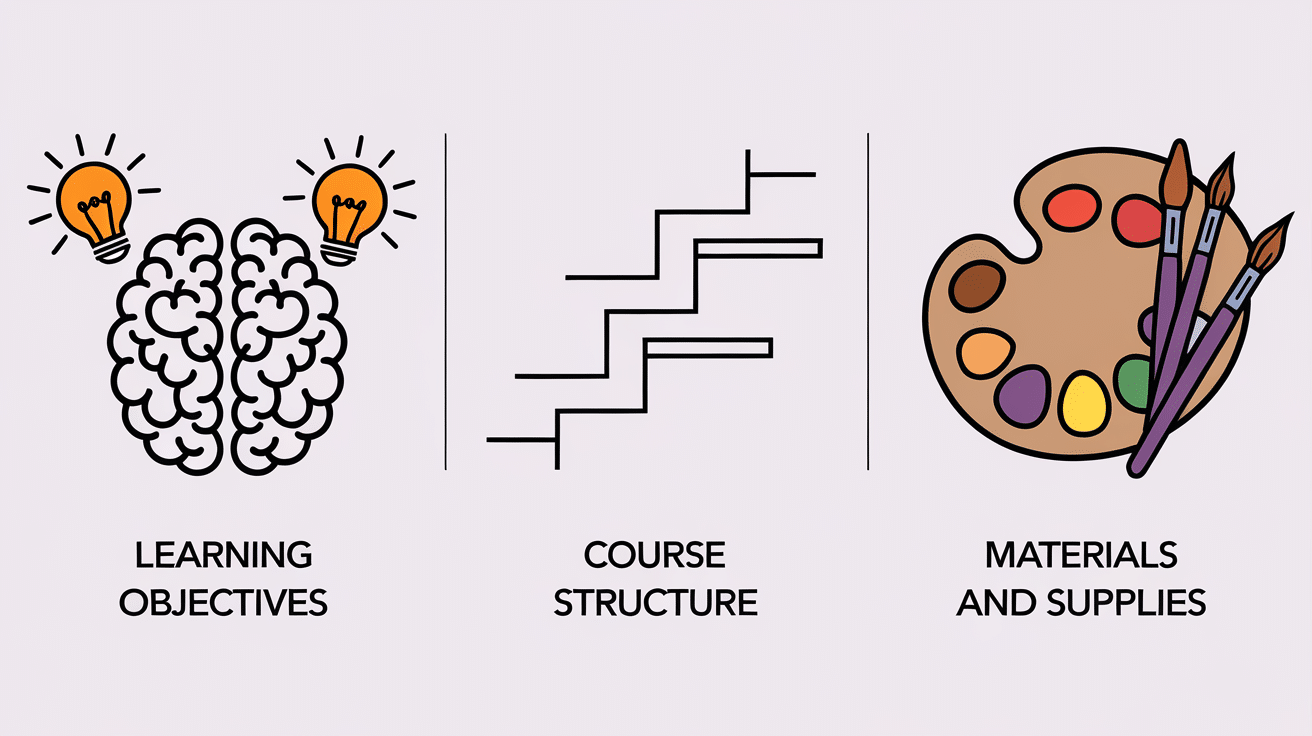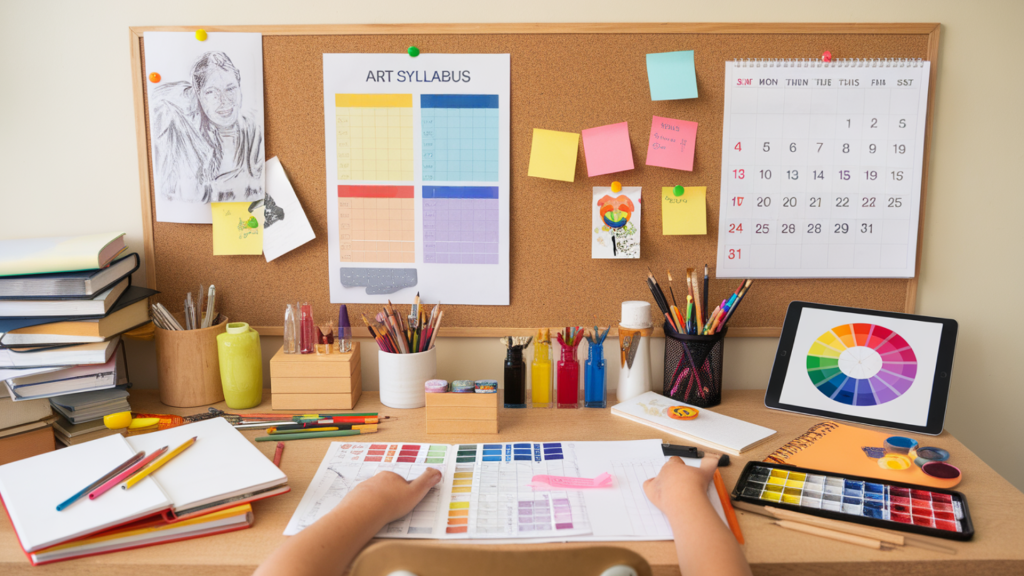A well-structured middle school art syllabus helps teachers organize lessons while giving students a clear understanding of course expectations.
It outlines learning objectives, materials, classroom rules, and grading criteria. By using a syllabus, teachers can ensure a balanced approach to art education, covering creativity, technical skills, and art history.
A syllabus template saves time and provides consistency. Teachers can customize it to match their teaching style and course structure.
This guide explains how to create an effective middle school art syllabus, covering essential elements such as course structure, materials, and assessment methods. With a well-planned syllabus, students can stay engaged and develop their artistic abilities in a structured way.
What Is a Middle School Art Syllabus?

A middle school art syllabus is a document that outlines the structure and expectations of an art course. It provides an overview of topics, assignments, and grading policies.
Students use the syllabus to understand what they will learn and how they will be evaluated throughout the course.
A syllabus serves as a guide for lesson planning for teachers. It ensures that important concepts are covered in a logical sequence. A well-organized syllabus keeps the class on track and allows for smooth transitions between topics.
By following a structured syllabus, students can develop their artistic skills while understanding the importance of creativity and self-expression.
Key Components of an Art Syllabus

A well-designed art syllabus includes several key components. Each section ensures that students receive a balanced and engaging learning experience.
Learning Objectives
Learning objectives outline what students should achieve by the end of the course. These objectives help students stay focused while allowing teachers to measure progress.
Some common objectives in a middle school art syllabus include:
- Understanding basic drawing and shading techniques
- Learning color theory and how colors interact
- Trying different art styles and techniques
- Developing skills in painting, sculpture, and digital art
- Analyzing famous works of art and understanding their historical context
Clearly stated learning objectives help students understand the purpose of each lesson and stay motivated throughout the course.
Course Structure
The course structure breaks down the syllabus into specific units or topics. It provides a timeline for different activities, ensuring that students learn concepts in an organized way.
A sample course structure may include:
- Weeks 1-3: Introduction to drawing techniques (line work, shading, perspective)
- Weeks 4-6: Color theory and painting techniques
- Weeks 7-9: Sculpture and three-dimensional art
- Weeks 10-12: Digital art and mixed media projects
- Weeks 13-15: Art history and cultural influences in art
- Weeks 16-18: Final project and portfolio presentation
Breaking the course into structured sections helps students develop skills step by step, making learning more manageable and enjoyable.
Materials and Supplies
Providing a list of required materials ensures that students are prepared for each lesson. Essential supplies for a middle school art class may include:
- Sketchbooks and drawing paper
- Pencils, erasers, and sharpeners
- Watercolors, acrylic paints, and brushes
- Clay and sculpting tools
- Digital tools for creating artwork on tablets or computers
By listing materials in advance, teachers help students stay organized and avoid last-minute confusion.
How to Use a Middle School Art Syllabus Template
Using a syllabus template helps teachers create a structured and well-organized course plan. A well-prepared syllabus makes it easier for students to understand expectations, deadlines, and grading policies while ensuring that lessons are planned efficiently.
Instead of spending time organizing documents, teachers can focus on making lessons interactive and engaging.
1. Choose a Syllabus Template that Suits Your Teaching Needs.
Selecting the right syllabus template is the first step in creating an organized course outline. The template should include sections such as course objectives, grading policies, classroom expectations, and materials.
Some schools provide standardized formats, while others allow teachers to create their own. Teachers should choose a template that fits their preferred structure while ensuring all necessary details are included.
A well-designed template makes it easier to manage lesson planning and keeps information clear for students and parents.
2. Customize the Template with Specific Course Details.
Once the template is selected, teachers should modify it to reflect their specific course details. This includes adding the course title, instructor’s name, and contact information.
A brief introduction should explain what students will learn, the skills they will develop, and the types of projects they will complete.
Customizing the syllabus also involves adjusting the format based on whether the course is taught in person or online. Making these adjustments ensures the syllabus aligns with the teacher’s teaching style and class requirements.
3. Include Learning Objectives and Project Outlines.
Learning objectives define what students should achieve by the end of the course. These should be specific and measurable to help students stay focused and motivated.
Common objectives for a middle school art course include mastering drawing techniques, understanding color theory, learning different artistic styles, and working with various materials like paint and clay.
Teachers should also outline major projects, such as self-portraits, still-life drawings, or collaborative murals. Listing objectives and projects helps students see the purpose of each lesson and track their progress throughout the term.
4. Set Deadlines and Grading Policies
A clear grading policy helps students understand how their work will be evaluated. Teachers should outline how participation, classwork, homework, and final projects contribute to the final grade.
Providing a grading breakdown, such as 40% projects, 30% class participation, and 30% written reflections, ensures fairness and transparency. Deadlines should be clearly stated, with due dates for assignments, quizzes, and presentations.
A structured grading and deadline system helps students manage their workload and encourages responsibility.
5. Add Classroom Rules and Participation Expectations
Establishing clear classroom rules ensures a respectful and productive learning environment. Teachers should include guidelines on classroom behavior, use of materials, and participation expectations.
Rules may include treating supplies with care, cleaning up after projects, listening respectfully during critiques, and submitting work on time. Policies on attendance, late work, and extra credit opportunities should also be detailed.
Clearly defining these expectations helps students understand what is required of them and encourages accountability.
6. Review and Finalize the Syllabus Before Distribution
Before sharing the syllabus, teachers should review it to ensure all necessary information is included and formatted correctly. Checking for clarity, accuracy, and completeness prevents confusion later.
Getting feedback from colleagues or school administrators can help refine the syllabus further. Teachers should also consider whether the syllabus is visually clear and easy for students to reference throughout the course.
A well-reviewed syllabus serves as a valuable guide for both teachers and students, helping to keep the class organized and focused.
7. Sharing the Syllabus with Students
Once the syllabus is finalized, it should be distributed to ensure its accessibility for all students. Teachers can provide printed copies for students to keep in their folders or share digital versions through platforms like Google Classroom, school websites, or email.
Reviewing the syllabus with students at the start of the course is essential. Walking through each section allows students to ask questions and gain a clear understanding of expectations. Teachers can also use this time to highlight important dates, key projects, and grading policies.
Encouraging students to refer back to the syllabus throughout the term helps them stay organized and prepared.
A well-structured syllabus serves as a valuable reference guide, ensuring that students remain focused on their learning goals while allowing teachers to manage their courses effectively.
Benefits of Using a Template for a Middle School Art Syllabus
Using a template for an art syllabus makes it easier for teachers to plan lessons while keeping content consistent, organized, and easy to follow.
A well-structured syllabus helps students understand what to expect throughout the course and gives parents a clear idea of classroom expectations. Templates also ensure that all necessary details are included, reducing the risk of missing important information.
Time-Saving
Creating a syllabus from scratch takes a lot of time. A template provides a ready-made framework that teachers can adjust based on their course objectives and curriculum. Instead of formatting a new document each school year, educators can update the template to reflect any changes or new projects.
This approach allows teachers to spend more time on lesson planning and student engagement rather than focusing on administrative tasks.
Easy Customization
A syllabus template provides flexibility while maintaining structure. Teachers can modify sections to fit their teaching style, student needs, and course format. As needed, adjustments can be made to the grading policy, project guidelines, or materials list.
Each class may have unique requirements, and a good template makes it easy to adapt without rewriting everything.
Consistency and Clarity
A syllabus template helps maintain uniformity in course planning. It ensures that teachers include all necessary details, such as class policies, learning objectives, and assessment criteria. This reduces miscommunication between teachers, students, and parents, making expectations clear from the start.
A well-organized syllabus also helps students stay on track by providing a clear breakdown of topics, assignments, and deadlines. Having all this information in one place prevents confusion and allows students to manage their time effectively.
Practical Tips for Teachers When Creating an Art Syllabus
A well-structured syllabus helps teachers manage lessons while providing students with clear expectations. It should outline rules and assignments and create an engaging and supportive learning environment.
Careful planning ensures that students stay motivated while developing their artistic skills. Here are some useful tips for improving syllabus design.
Balance Fun with Educational Value
Art classes should foster creativity while teaching essential skills. A good syllabus includes both structured lessons and open-ended projects. While students need to learn techniques such as shading, perspective, and composition, they should also have opportunities for self-expression.
Teachers can mix guided assignments with creative projects to keep students engaged. For example, after learning about color theory, students can create their own artwork using what they’ve learned.
Adding collaborative activities and themed challenges can also make lessons more exciting while reinforcing key concepts.
Incorporate Assessment Criteria
Students need to understand how their work will be evaluated. A syllabus should outline grading policies so students know what is expected of them. Providing clear criteria helps them focus on improvement rather than uncertainty about grades.
Assessment can include:
- Sketchbook exercises to track progress
- Class participation and engagement
- Mid-term and final projects
- Written reflections on creative growth
Teachers can also use rubrics to assess creativity, technical skills, and effort. Clear grading policies ensure fairness and help students understand how to improve.
Adapt for Online Learning
Digital tools are becoming more common in education, and art classes may include virtual assignments. A syllabus should provide clear guidelines for online submissions and digital tools.
Teachers can incorporate virtual gallery visits, online critiques, and digital drawing platforms to make learning more interactive.
Including instructions for submitting artwork electronically ensures that students stay on track, even in remote or hybrid learning settings.
Conclusion
A well-structured middle school art syllabus helps teachers plan engaging lessons while setting clear expectations for students. By using a syllabus template, teachers save time, ensure consistency, and provide a structured approach to teaching art.
An effective syllabus outlines learning objectives, materials, and assessment methods, helping students track their progress throughout the course.
By balancing creativity with structured lessons, teachers create an environment where students can develop artistic skills and confidence.
With the right syllabus template, middle school art teachers can focus on inspiring creativity while ensuring that students receive a well-rounded art education. A clear and organized course plan benefits both teachers and students, making the learning experience enjoyable and productive.
Frequently Asked Questions
Why Is a Middle School Art Syllabus Important?
A syllabus provides a structured plan for the course, helping students understand learning objectives, assignments, and grading policies. It also helps teachers organize lessons and ensures that students and parents know what to expect throughout the term.
What Should Be Included in A Middle School Art Syllabus?
A good syllabus includes learning objectives, course structure, materials list, classroom rules, assessment criteria, and project deadlines. It should also provide guidelines for participation, grading policies, and expectations for student behavior.
How Can I Make My Art Syllabus Engaging for Students?
Adding a mix of structured lessons and creative projects keeps students interested. Including interactive activities, student choice in projects, and collaborative work helps make the syllabus more engaging. Using a clear and visually appealing format can also improve student understanding.
Can an Art Syllabus Be Used for Online Learning?
Yes, an art syllabus can be adapted for virtual classrooms by incorporating digital tools, online assignments, and virtual critiques. Teachers can provide guidelines for submitting artwork online and include digital resources for lessons.
How Often Should I Update My Art Syllabus?
A syllabus should be reviewed and updated regularly to reflect new teaching strategies, curriculum changes, and student feedback. Adjustments may be needed each school year to improve lesson plans, update project deadlines, or add new art techniques.









